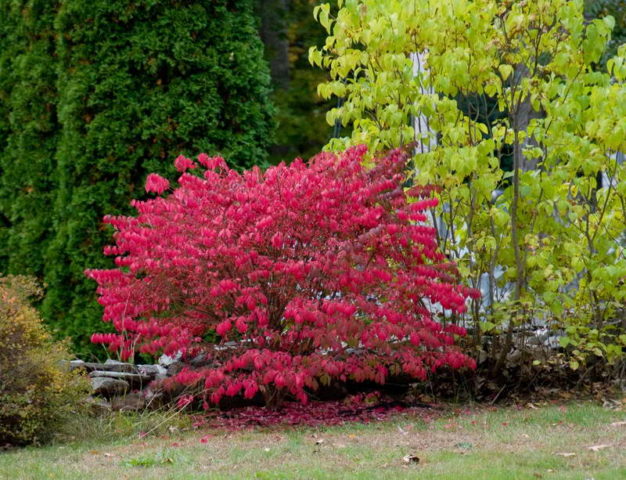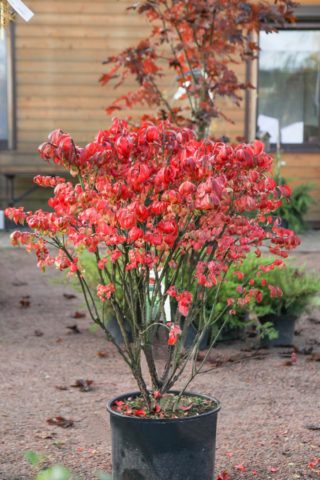Content
Photos and descriptions of winged euonymus will allow you to find the most suitable variety for growing. The shrub has brightly colored foliage and is undemanding to soil and care.
Description of winged euonymus
The Latin word for winged euonymus is Eunomus Alatus. This is a representative of the Euonymus family. In nature, the plant is found in the Far East, China and Japan. Its habitat: mixed forests, mountainous areas, meadows, river valleys. The shrub was first studied and described by Japanese scientists.
Characteristic
Euonymus is a deciduous shrub. The shoots are green, erect or creeping. The plant got its name due to its tetrahedral branches with horizontal growths resembling wings.
The leaves are small, dark green elliptical, from 2 to 7 cm long and 1 to 3 cm wide. The leaf blade is shiny, dense, without pubescence. In May-June, small flowers bloom, which are invisible against the background of green foliage. At the end of summer, bright crimson fruits in the form of boxes are formed.
In autumn, the leaves change color to crimson, orange or purple. The color depends on the variety and place of cultivation. When exposed to the sun, the foliage is at its brightest. In the shade the color becomes muted.
The winged euonymus is shown in the photo:
Height of winged euonymus
The size of winged euonymus depends on the variety. Under natural conditions, the shrub grows up to 3–4 m. In garden plots it reaches 2–2.5 m. It is characterized by weak growth vigor. Over the course of a year, the size of the shrub increases by 10–15 cm.
Winter hardiness of winged euonymus
The frost resistance of winged euonymus is high. It can withstand up to -34 °C. The shrub is suitable for growing in the middle zone, as well as in northern and mountainous regions. Autumn preparation helps increase its frost resistance.
Winged euonymus in landscape design
Euonymus is used in single and group plantings. The shrub helps create a hedge. For soliter planting, more free space is allocated under it. Low-growing plants are planted nearby. In autumn, a bright bush looks impressive against the background of a lawn.
Winged euonymus looks good next to other trees and ornamental shrubs. It is combined with conifers, jasmine, viburnum, rose hips, broom, barberry.
The shrub is suitable for decorating personal plots, recreation areas, alleys and parks. The varieties tolerate gas and urban pollution. You can plant shrubs next to a pond, fountain, terrace, or gazebo.
Varieties of winged euonymus (Euonymus Alatus)
There are several varieties of this species. They all differ in the size of the bush, the color of the leaves and fruits.
Euonymus winged Compactus
According to the description, winged euonymus Compactus reaches a height of 1.5 m and a girth of 2 m. The crown is regular in shape, thickened, and lacy around the edges. The leaves are bright green in summer and turn reddish-purple in autumn. The leaf blade is rounded, 3–5 cm long.
Small flowers bloom in May-June. They are yellow-green in color and are hardly noticeable against the background of green leaves. In autumn, orange-red fruits ripen and hang on the branches until winter.
Euonymus winged Compactus is planted in a sunny place in the garden. In the shade, decorative properties are significantly reduced. The variety needs frequent watering.
Euonymus winged Chicago fire
The Chicago Fire variety grows up to 1.2 m in height. The width of the bush is 1.5 m. The crown is rounded, the shoots are horizontal. The leaves are simple, elliptical in shape. In summer the color is dark green. In autumn, the winged euonymus changes color to bright crimson. The flowers are inconspicuous, appear in May, and do not stand out against the background of the foliage. The fruits are 8 mm long and ripen in a dark red shell.
The Chicago Fire variety grows well in shady and sunny places. It is unpretentious in soil composition, the main requirement is fertility. Growth rates are moderate. The variety has high frost resistance, but freezes slightly in severe winters.
Euonymus winged Fireball
The winged euonymus shrub, variety Fireball, is a deciduous shrub with a spherical crown. The plant is dense and compact. The variety grows slowly. The shoots are ribbed, hard, with corky growths. In the middle zone it grows up to 1.5 m in height. The girth reaches 1.5 m. Over the year it grows 5–10 cm.
The leaves are green, elliptical in shape, lighter on the underside. The length of the leaf blade is 2–5 cm. In autumn, the leaves become red with a purple and lilac tint. In the shade they are mauve.
The flowers are inconspicuous, green-yellow, collected in umbels of 3 pieces. Flowering is abundant, occurring at the end of May - beginning of June. The fruits are orange-red and are in boxes.
The shrub prefers fertile soils with moderate humidity. In spring and autumn, pest control is required. The plant is planted in the light, but partial shade is also allowed.
Euonymus winged Macrophilis
Euonymus variety Macrophilis is a deciduous shrub up to 1.5 m high and 1.2 m in diameter. Shoot growth is moderate. The flowers are small and inconspicuous, almost invisible.
The Macrophilis variety differs from other varieties in its elongated leaves. In summer they are dark green, while in autumn they turn carmine in color. The fruits are orange-red and ripen in capsules.
The winged euonymus tree prefers sunny places, but it is planted in partial shade. With a lack of lighting, the color becomes less bright. The Macrophilis variety requires fertile soil and moderate watering.
Planting and caring for winged euonymus
To successfully grow euonymus, planting rules are followed. Provide regular care throughout the season.
Landing rules
Euonymus Alatus is planted in early spring or late autumn. For it, choose a sunny area or light partial shade. The soil should be light and fertile. Acidic soil is limed before planting. Since the bush grows over time, it is removed 3–4 m from buildings and other crops.
Procedure for planting euonymus:
- A hole 60 cm deep and 80 cm in diameter is dug under the seedling.
- A drainage layer of broken brick or expanded clay is poured onto the bottom.
- The pit is filled with a mixture of black soil and compost and left for 3 weeks to shrink.
- The seedling is placed in a hole, the root collar is placed at ground level.
- The roots are covered with soil, compacted and watered abundantly.
Watering and fertilizing
Basic care for winged euonymus includes watering and fertilizing. The shrub prefers soil with moderate humidity. Stagnation of moisture, as well as drying out of the soil, are unacceptable. To reduce the number of waterings, the tree trunk circle is mulched with humus or peat.
The bush is fed throughout the season. In early spring, organic matter containing nitrogen is added: an infusion of bird droppings or mullein. Fertilizing stimulates the growth of new shoots and leaves. In the summer they switch to fertilizing with complex fertilizers. Any preparation for ornamental shrubs is suitable for this. Such complexes contain nitrogen, phosphorus and potassium.
In late autumn, mineral fertilizers are added to the soil. For 1 sq. m requires 500 g of superphosphate and 400 g of potassium sulfate. The substances are embedded in the soil to a depth of 10 cm. Instead of mineral fertilizers, you can use compost and wood ash.
Pruning winged euonymus
By pruning, the shape of the bush is adjusted.Usually they try to get a cone-shaped or elliptical crown. Treatment is carried out in early spring or autumn, after leaf fall has passed. Sanitary pruning is performed annually. The bush is inspected and broken, dry and frozen branches are cut out.
Preparing winged euonymus for winter
Autumn preparation will help the bush survive winter frosts. First, the euonymus is watered abundantly. Wet soil freezes more slowly and becomes protection from the cold. Then a layer of humus or peat mulch is poured into the tree trunk circle.
Young plantings need more careful shelter. A frame and wooden planks or metal arches are built above them. Covering material is attached to the base. It is best to use spunbond or agrofibre, which allow air to pass through well. Seedlings often rot under polyethylene. The shelter is removed when the snow begins to melt and the air warms up.
Reproduction of winged euonymus
Methods for propagating euonymus:
- By layering. In spring, choose a strong and healthy shoot. It is bent to the ground, secured with metal brackets and covered with earth. The layerings are looked after throughout the season: watered and fed. In autumn, the shoot is separated from the main bush and planted in a new place.
- Dividing the bush. Euonymus has branched powerful roots. This method is convenient when transplanting shrubs. The root system is divided into parts, the sections are sprinkled with charcoal. The resulting seedlings are transferred to a new location.
- Cuttings. In early spring, cuttings 10–12 cm long are cut. They are placed in water, to which a root formation stimulator is added. Then the cuttings are planted in a greenhouse or containers with fertile soil. In autumn, seedlings are ready to be planted in the ground.
- Seeds. The most complex and time-consuming method.The seeds are stratified and soaked in a solution of potassium permanganate. Even in this case, the probability of seedlings appearing is quite low. The sprouts are kept at home, they are provided with watering and fertilizing. In the 3rd year, the seedlings are transferred to open ground.
Diseases and pests
Euonymus is susceptible to powdery mildew. The disease manifests itself as a white coating on the leaves. To combat the lesion, Bordeaux mixture or copper oxychloride is used. The bush is sprayed in dry, cloudy weather. If necessary, the treatment is repeated after a week.
The shrub may suffer from attacks by aphids, caterpillars and spider mites. Insects feed on plant juices. As a result, the development of the euonymus slows down, and the leaves curl and fall prematurely. The preparations Fitoverm and Confidor are effective against pests. Spraying is carried out every 10 days.
To prevent diseases and pests, it is important to follow agricultural practices. In autumn, dig up the soil and remove fallen leaves.
Reviews of winged euonymus
Conclusion
Photos and descriptions of winged euonymus will help you choose a variety suitable for each garden. The shrub tolerates cold winters and is unpretentious to weather conditions. To maintain growth, it is provided with care: watering, fertilizing and pruning.



















Euonymus is very beautiful at any time of the year. A wonderful shrub. Only sometimes it doesn’t turn red. From what?